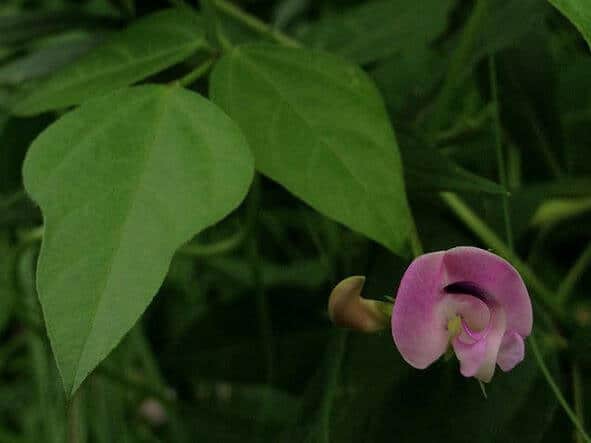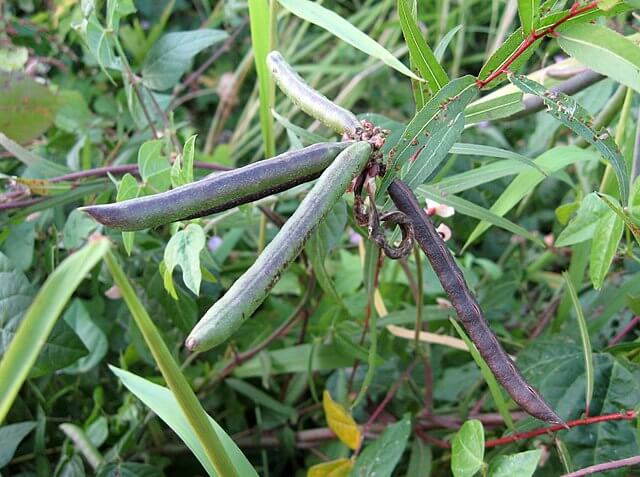It’s odd to think of picking beans at the beach, but that’s exactly where you’ll find Strophostyles helvola, aka trailing wild bean, amberique bean, or annual wooly bean. Trailing wild bean grows in many soil types, but it thrives in the dry, sandy soil and direct sunlight of coastal beach dunes. A legume and member of the Fabaceae family, this plant is a North American native and close relative to many species of bean we grow in our home gardens. While trailing wild bean grows sparsely in the wild, it can be cultivated in a domestic garden as a unique food source and a strong pollinator attractant.

Trailing wild bean is an annual vining plant that can grow up to 8 feet long. Its teardrop shaped leaves grow in an alternating pattern along the vine, and the flower buds appear in dense clusters on long stalks. The buds open at the height of summer, and their shape and pinkish purple color make them look strikingly like the sweet pea flower, a nod to trailing wild bean’s membership in the pea family. The edible part of the plant, the bean pod, grows at the base of the flower and looks like a skinny green bean. The fruit can grow up to three inches long and is green when young, but it turns brown as it reaches maturity and dries out.
Edibility and Culinary Use
Like most beans, the fresh pods can be eaten whole when raw or cooked. They make an excellent additive to sauteed vegetables or hearty soups. Once mature and dried, you can shell the beans and cook them by boiling like any other dried bean, or you could roast them. Ever had a wasabi pea? Think of them like that! Simply toss them lightly with oil and the seasoning of your choice, then roast away. For the most tender pods, it is best to pick and eat the pods when they are young—anywhere from mid-summer to mid-fall.

Medicinal Uses of Trailing Wild Bean
You may struggle to consider the medicinal aspects of a bean, but Native Americans actually used these beans for common ailments ranging from typhoid, warts, and even as a way to battle the rash caused by poison ivy.
Cautions
This plant is in the taxonomical family Fabaceae(Legumes). Legumes have pods that resemble peas and beans and some legumes are toxic. This plant can be identified by its compound leaf with 3 leaflets and it’s bean shaped pod rather than pea-shaped. With that said always do thorough research using multiple sources to confirm identification of any wild edibles that you plan to consume.
If you choose to forage for this plant, you should use caution regarding your ecological footprint. This edible bean does not grow prolifically, so be conservative with your pickings. Always be sure to leave multiple pods to dry and turn to seed, as this is how the plant reseeds itself to grow again the next year. Another aspect you should hold in consideration is the plant’s habitat—sand dunes. Sand dunes help prevent flooding, harbor many species of living creatures, and help replenish the coastline as sand erodes away. Dunes are fragile, imperative parts of the coastal ecosystem and can be easily destroyed by trampling feet. Please use caution and try your best to leave no trace!
Conclusion
Trailing wild bean is a hearty foraging food that can be tamed for the home garden, so it may be wise to try to cultivate it yourself rather than disturb the sparsely appearing wild plants. However, should you come across a vine or two at your local beach, take a moment to admire its fantastic flowers or even take a few pods for a beach walk snack. As long as you commit yourself to sustainable foraging, you can reap the rewards.
Many of our readers find that subscribing to Eat The Planet is the best way to make sure they don't miss any of our valuable information about wild edibles.
See our privacy policy for more information about ads on this site






